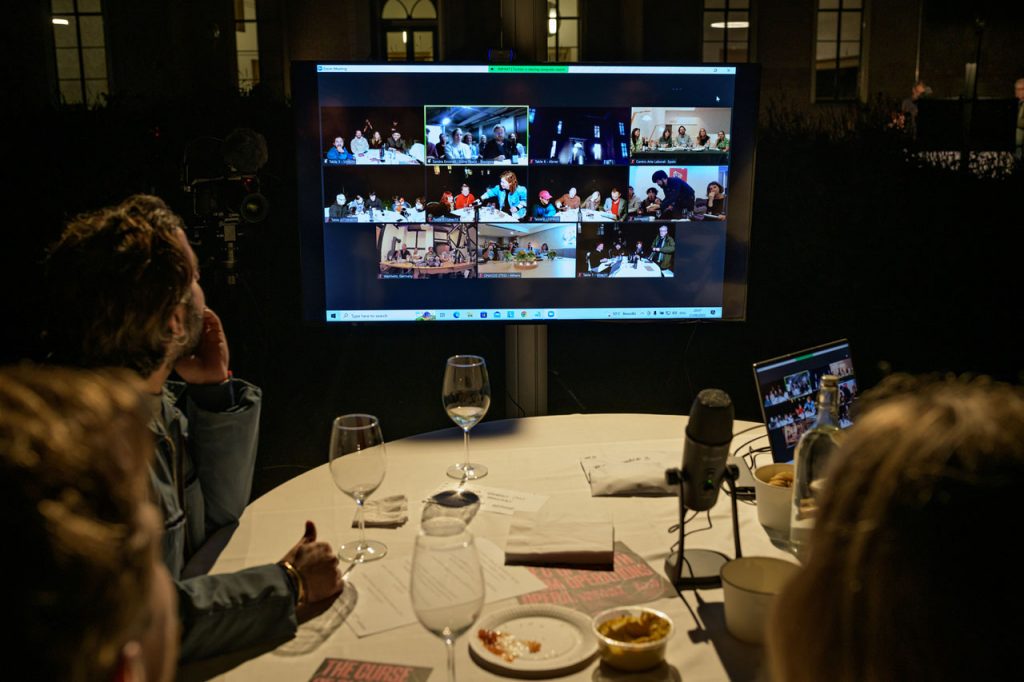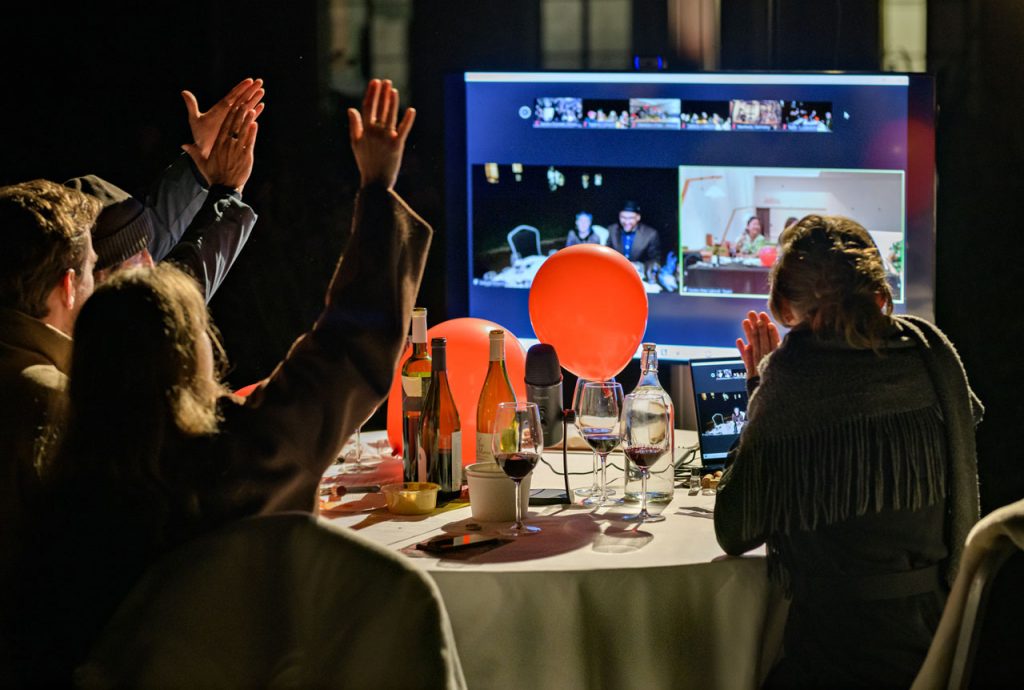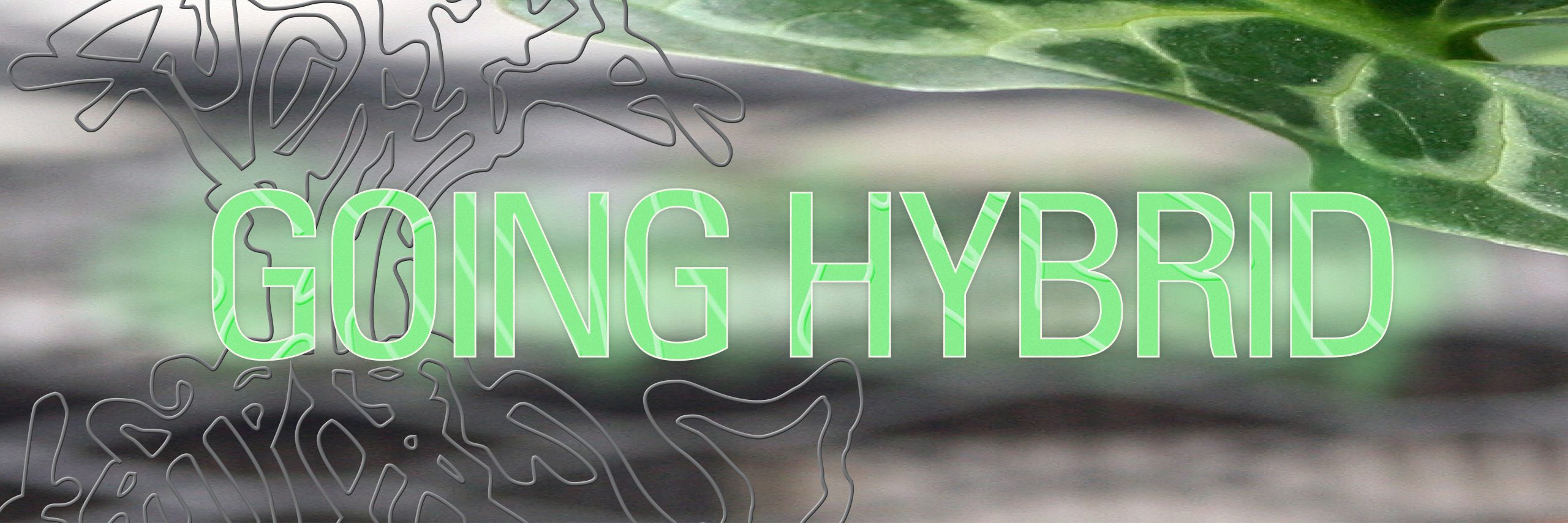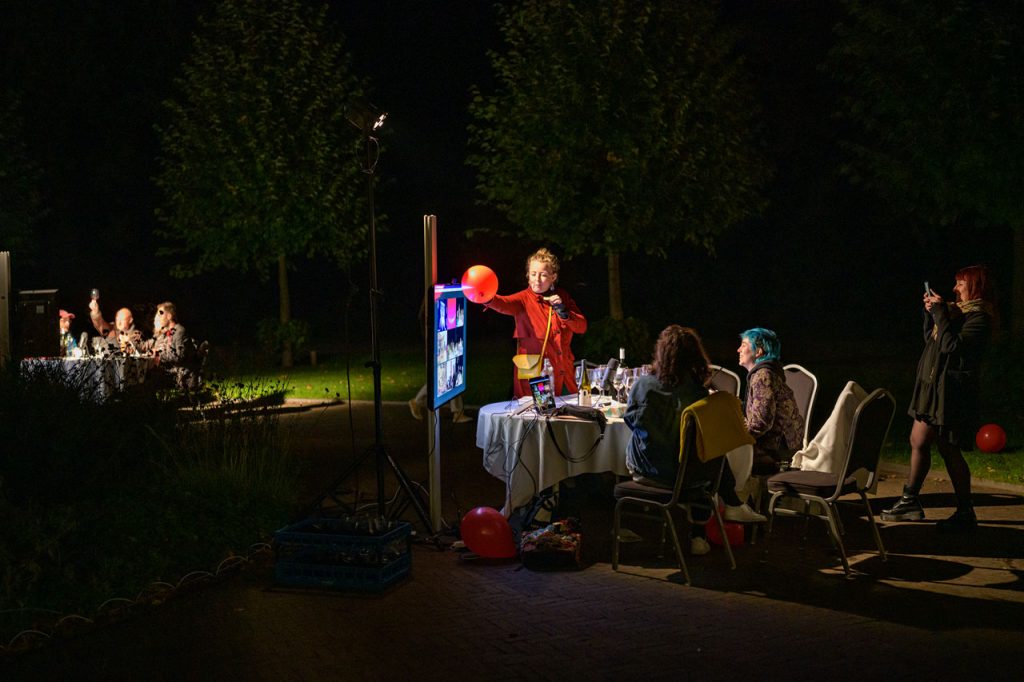In some sense, this is amusingly relevant to the concept of the hybrid event; as we become increasingly hybrid, we realise that connections are established and maintained in a combination of groundbreakingly new, as well as many traditional, tried, and tested ways.
View from an onsite prespective. Photo: Pieter Kers
We arrive by bike at a relatively remote location, the mansion house and garden at Oud Amelisweerd. There are five tables around a central perimeter, each with a screen in front of them, chairs on the opposite side, and neatly dressed up for the occasion. Tech set-up is still in progress, and a handful of colleagues are running around ensuring that things will run as smoothly as possible. My role comes later, when I will host one of these tables for the evening.
With showtime looming, we test the cameras and microphones and whatnot. We have people tuning in from around the world, well, Europe mostly. That is because this event takes place not only on the five tables in Utrecht but is a shared experience with five other cultural institutions across Europe, all part of the European Media Art Platform. Each location hosts a table with four to six people; some are employees, others are resident artists, and the Croatians even invited a winemaker. In Utrecht, it is a mix of guests from IMPAKT’s network and people that bought a ticket, but one thing they all have in common tonight is that they are not part of a silent audience but actively part of the event, making the line between audience and participant fade. The evening’s host, Abner Price, an artist using both VR and performance in his practice, opens the night and explains the program for the evening. We will have five rounds, where each European organisation will introduce a wine they selected from their region, explaining why they have chosen this particular one. The table hosts in Utrecht and across Europe will open a bottle of precisely that wine, and pour a glass to each person sitting at the table, after which the host will explain an activity focusing on one of the five senses, and in just a click each of the tables from around Europe will be paired with one of the tables at the mansion. This will be repeated five times, so all the European tables will be connected to each of the tables at Oud Amelisweerd, and each will be able to represent their wine. Part of the excitement is in this wine, the drinking, the snacks, and part of it are in the sensory activities, but all of this works together to catalyse the social aspect, the chats, getting to know people beside you, around you, as well as on the screen, someplace hundreds of kilometres away. As each city has chosen its nicest setting and dressed its table similarly, it feels like the two tables in the two cities become one. With these familiar elements in a new hybrid setup, you almost forget that the entire affair is the exploration of hybrid aspects. The key is variety and variation, moving through elements, and staying engaged.

Tasting wines together through tables and screens. Photo: Pieter Kers
As the evening progresses, we participate in various engaging multi-sensory activities. One involves drawing portraits of each other on wine labels, with elements of the traditional label included in the picture. What kind of wine am I, a Rioja or Montepulciano? What percentage of alcohol do I represent? As we are forced to stare at each other during this exercise, what is awkward becomes amusing, and we find each other forthcoming and increasingly engaged. Another activity involves trying to guess a scent, which, come to think of it, might be compromised by the effects of wine on the palette. Still, the aim here is not the answer but rather the conversation between the people on both sides of the table experiencing the same smell. As we drink, we are presented with pairings to stimulate the various senses. We cast votes on our favourite wines through the Mentimeter, an online real-time polling tool that some of us are more familiar with than others, and which raises its own set of social and practical queries, “How does it work?” not being the least of them. Here, my role as the table host comes in, ensuring these kinds of technical issues are solved easily, and the guests at the table understand what is needed at each step. Participants scan a QR code and are taken to an online poll where they place their votes, which are then displayed on the screen when the voting is done.

Participants in the hybrid sensory activities. Photo: Pieter Kers
The art component lies in the engaging way the evening is constructed, in the theatrical way the hosting takes place, but most of all in how we interact with each other through the activities, using everyday items in an experimental way. It becomes something like a big performance, and the fact that everybody shares the same props and engages in a similar choreography makes it feel like we are all part of the same play. We share food and stories, discussing the background of a particular wine, snack, or social custom, as villagers gathered around a fire. We comment on each other’s environments; “Wow, the French have such a cosy space!”. As the event goes on and the wine begins to flow at exponentially liberal rates, the general cohesion of the whole thing begins to slip away. Words start to slur, voices begin to rise with excitement, and technical difficulties become increasingly more, well, difficult. Before I know it, I am meandering along the road home, and soon I am in my kitchen, the leftovers of a bottle of white I probably won’t drink adorning the table.
The next day’s somewhat hungover reflections focus on how it all came together, functionally and technically speaking, and what was happening “behind the curtain”. The interconnection between locations was based on a setup in Zoom, using a paid account, as we were surely going over the 40 minutes a free account allows. The central moments were simply a general Zoom meeting, most of the times in speaker view, with the host visible at one of the Utrecht tables, and on occasions using a spotlight in order to have the host in conversation with one of the European tables, either to discuss their wine or talk about an activity they just took part in. The round table sessions connecting the different Utrecht-based tables with the European ones were done using the break-out room option, with just the remote table visible on full screen. One of the puzzles we had to solve was the schedule of connecting the tables, as we had to make sure every round had a unique pairing. Although Zoom allows you to pre-pair this, we found it easiest to connect them manually. Another challenge was that we didn’t want to cut off conversations at the end of the round, so we allowed people to return to the central room by themselves, using the time Zoom allows to gather again. To not make this into an awkward silence, we chose to play a song, each round selected by one of the five European countries. In Utrecht, the biggest challenge was ensuring there was no problem with audio feedback or noise overspill from other tables, allowing a maximum of six people to be clearly audible for the tables they were paired with. Luckily the weather allowed an outdoor setup, giving us the option to spread the tables over the large garden. For all tables, both in Utrecht and in the other European cities, we asked to use the same hardware setup; a large screen, or a projection, an external webcam set up in a position that allowed all table guests to be visible, and an omnidirectional external microphone. To ensure the quality of the audio and image was good at all locations, we asked them to do a tech check on a day before the actual event, and we asked the table hosts to be present at the latest 30 minutes before the program started. As most organisations arrived rather last minute, some of our tech colleagues found themselves running around finalising technical details with showtime a few minutes away. Since a good internet connection is essential for an event like this, we required wired internet, not only from the European partners but also for our setup. Given that we had to spread the tables over the garden, we needed to use hundreds of meters of Ethernet cable. In some sense, this is amusingly relevant to the concept of the hybrid event; as we become increasingly hybrid, we realise that connections are established and maintained in a combination of groundbreakingly new, as well as many traditional, tried, and tested ways



